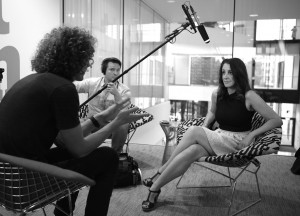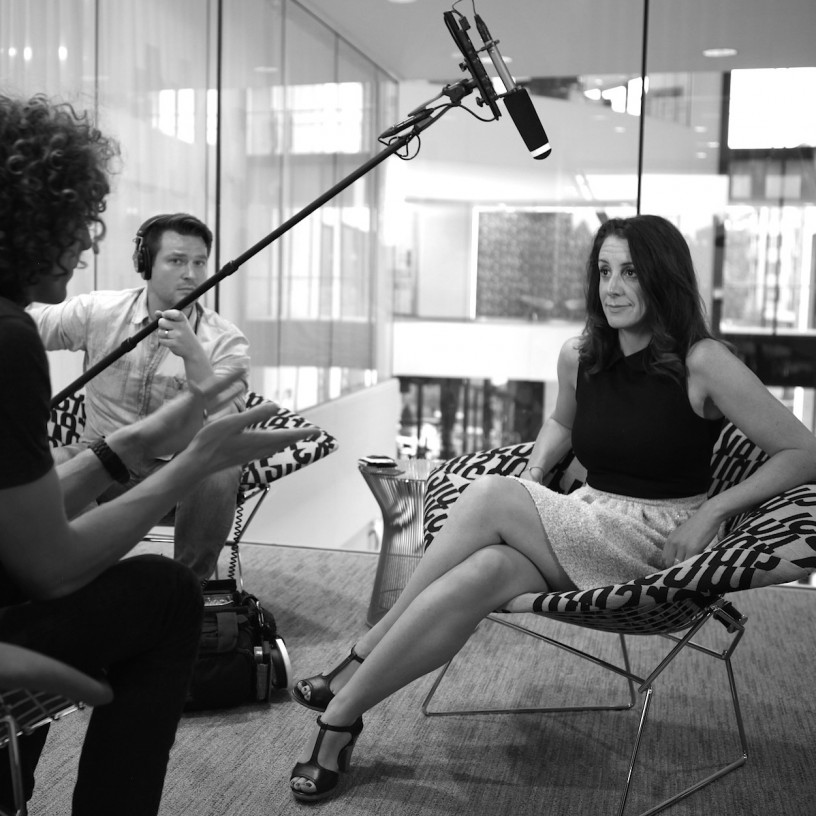
LUCY SIEGLE
AUTHOR & JOURNALIST
Lucy Siegle is an author, journalist and presenter based in London. She has written a weekly ethical living column for the Observer for over the last decade, while also authoring two books. Lucy is also an Executive Producer on The True Cost and we sat down with her to talk about the factory collapse at Rana Plaza, what change (if any) has happened in the industry since then, and how she now purchases clothing.
How did you first become interested in writing about the effects of the fashion industry?
As a young journalist I began writing about green living and ethical consumerism for a younger audience (up to then most of the writing on green living encompassed spiritual ecology (I’m not a fan) or was for an older generation of ex hippies).
“The stories I unravelled about the fashion supply chain were unbelievable in terms of egregious pollution and blind exploitation and the story has just got bigger and bigger.”I became a sort of agony aunt for the environment where readers would send me their green issues. Having worked my way through the nation’s store cupboards turning things Fairtrade and organic, allotment (backyard) food growing, cycling etc., I finally got to sorting out the average closet. You could say I never left. The stories I unravelled about the fashion supply chain were unbelievable in terms of egregious pollution and blind exploitation and the story has just got bigger and bigger. Follow the money, follow the oil, follow the fashion.
As you researched and wrote ‘To Die For’ (a book that greatly inspired my own research for this film) what was the most surprising thing you discovered?
“I realised there were a number of flashpoints in the supply chain that were adding up to extreme exploitation and possible catastrophe and that this was a standard business model.”I was struck by how quickly a sustainable system can be undone and destroyed forever. So local textile and garment cultures are pretty much annihilated by the just-in-time outsourced model of today’s global brands and retailers. And yet these are the companies that pretend they are in the business of creating opportunities in low-wage economies. The most shocking thing was when I realised that most western buyers were using completely nonsensical calculations when they placed orders in first tier factories. This means the factory they look around can’t possibly complete the gigantic orders they place and will obviously outsource, and this is a classic point at which sweatshop labour becomes a reality. I realised there were a number of flashpoints in the supply chain that were adding up to extreme exploitation and possible catastrophe and that this was a standard business model. So many of those flashpoints led to Rana Plaza.
After writing the book, the worst industrial tragedy in the history of fashion took place outside of Dhaka, Bangladesh. What happened that day and what did it feel like for you to read the headlines as the story unfolded?
Oh, I still find it really difficult to talk about. I’d gone into so much supply chain detail (as I mentioned in the previous answer) and given so many talks and written so many pieces and actually I totally failed to change anything. I felt a profound sense of despair. I remember getting a call when I was at the station waiting for a train from a radio show asking me to comment, and at that point we didn’t know very many details and I just kept saying, ‘I hope it’s not a garment factory,’ when ultimately I knew that it would be. The garment workers in the Cut, Make & Trim army always dominate the casualty lists of international disasters. And then we found out that they’d been sent back into the building.
We are coming up on two years after that horrific event, has there been substantial change?
“It is a total disgrace that the compensation fund is still depleted and people may have died from their injuries while awaiting compensation.”No there has not been. Opportunities were missed to reinvent the supply chain and I cannot say with any confidence that there will not be a repeat of Rana Plaza in terms of scale. Hundreds of people have lost their lives, been injured or had their health compromised by producing garments since Rana Plaza and the garment industry remains dangerous, polluting and energy intensive when it need not be any of these things. My feeling now is that brands and retailers were allowed to control and lead negotiations in the aftermath and were not selfless enough in the way that they approached them – and you might say, why would they be? It is a total disgrace that the compensation fund is still depleted and people may have died from their injuries while awaiting compensation. There’s not much good news here and I feel now that there should have been a greater push to make brands and retailers accountable legally, rather than allowing yet more voluntary codes of conduct.
A lot of brands are speaking more openly today about their CSR efforts. How are you able to determine the difference between real dedication to change and simply more sophisticated PR?
 I get suspicious when the PR is super sophisticated but the business model stays the same! That worries me. There are a few essential truths here: a) it’s easy for brands/retailers to look at ‘green’ stuff including using novel eco fibres and recycling waste clothes before living wages and the tricky people stuff b) when they are looking at wages in a few pilot schemes but pushing on into new low-wage fashion production hubs such as Myanmar and Ethiopia we have to spot the contradiction c) if your business model is based on furious expansion, really how will that ever square with being sustainable?
I get suspicious when the PR is super sophisticated but the business model stays the same! That worries me. There are a few essential truths here: a) it’s easy for brands/retailers to look at ‘green’ stuff including using novel eco fibres and recycling waste clothes before living wages and the tricky people stuff b) when they are looking at wages in a few pilot schemes but pushing on into new low-wage fashion production hubs such as Myanmar and Ethiopia we have to spot the contradiction c) if your business model is based on furious expansion, really how will that ever square with being sustainable?
But you’re right about the level of sophistication. With some notable exceptions, the fashion media remains rather silo-ed focused on aesthetics, shows, celebrities – all that jazz. Increasingly its job is to flog product so it tends to be uncritical. Meanwhile the big names in apparel retail are part of huge groups, possibly involved in other sectors with huge, corporate influence, lobbyists and all that attends global players. Both luxury and fast fashion have become investor driven in the last 4-5 years and this is the market they tend to respond to. I’d argue many of these corporations aren’t really interested in fashion, just shifting money about, so this leads us into politics…
How has your work changed the way you buy clothes?
I definitely buy them with a heavier heart! Aside from the odd emergency buy I’m a lot more thoughtful about what I buy, when and from who. I’m inquisitive about the supply chain and I will patronise brands and designers (even a one man band) who is doing something differently. This means I spend a lot more on my clothes than I used to for fewer items. But I’m not just buying more expensive mainstream brands (which doesn’t guarantee much)- I’m actively looking out sustainable makers. This also means I acquire much more slowly. I’ve made that decision. Because I don’t have a big income I have become much more self reliant and good at looking after clothes. I even knit my own sweaters. I also had to give up trends. Sometimes this worries me, as I used to love wearing the latest thing and I’ll admit to a latent anxiety if I don’t have the right cut of jeans or whatever but I force myself to be defiantly off-trend. I also work on TV in the UK and that eats up clothes (in terms of you can’t be seen in the same thing every time) so I have a lot of pieces on an extensive rota. I actually now have a huge wardrobe, and also have a few vintage pieces (this is something that’s quite new for me) that are just incredibly well made.
Is sustainable fashion a contradiction or a real possibility?
“Fashion has been co-opted by turbo charged capitalist corporations who are kicking the shit out of it and stripping fashion of its culture.”As we live in a time when ‘literally’ no longer means ‘literally’, I’m going to ignore the idea that ‘sustainable fashion’ is an oxymoron. Yes, it would be more sustainable if we all walk about in a burlap shirt and dungarees but that’s not going to happen. So it’s a real possibility because a) sewing clothes is not inherently dangerous so I believe we can stop killing people in the supply chain if we want to b) other industries with much more complex supply chains have come up with very clever ways of lowering impact and pollution c) if we empower designers they are incredibly innovative problem solving people and will natural gravitate toward sustainability. But the following needs to stop: fashion has been co-opted by turbo charged capitalist corporations who are kicking the shit out of it and stripping fashion of its culture. This will be the end of all fashion, sustainable or otherwise.
Is it possible for us to correct the trend towards more and more cheap disposable clothing?
Oh, I used up my ultimatum above! It is probably not possible unless there’s a catastrophic recession in terms of hoping that we’ll all shift to buying one coat a year and handing down skirts to the next generation etc. But there’s a midway if we can show some restraint – this is analogous to renewable energy. Solar and wind only become feasible as a major energy source if you power-down first. At the moment the fashion industry is going nuts for circular economy stuff, biodegradable fabrics and clothes recycling. All good stuff – to a point. But it won’t work in a chaotic system. There are still a lot of technical barriers – such as in clothing recycling, where too many novel blended fabrics add complexity – in reality it will take extraordinary investment in recycling systems etc. to come good on this idea that current gargantuan inventories can be made sustainable.
Look at the fashion landscape with an ecological eye, and it worries me that it’s becoming a monoculture controlled by a handful of super brands. The more biodiversity with smaller hubs of makers and styles and fashion cultures, the more resilient it will be.
What are the things you see taking place today that makes you hopeful moving forward?
“So here’s a brand that through intelligence, relationships with suppliers and designers and consumers can make affordable, ethical fashion. It’s not rocket science!”Loads of professional, young women who take ethics very seriously moving into clothing retail or setting up their own brands. From Birdsong to Reve en Vert to The-Acey to Keep Boutique in Brixton to Lily Cole and Katharine Poulton’s North Circular knitwear brands. They’re not interested in doing fashion without environmental and social justice and they’re driving this whole thing forward.
Secondly, a brand like People Tree (featured in the True Cost) that is producer centric coming up with solutions to all these apparently intractable problems. So here’s a brand that through intelligence, relationships with suppliers and designers and consumers can make affordable, ethical fashion. It’s not rocket science!
You’ve come on the film as an executive producer, as we prepare for the release what is your biggest hope for this project?
“My biggest hope is that it joins the dots for everyone that watches it. This fashion business IS politics, it IS humanity and it IS a matter of life and death.”I think True Cost is an extraordinarily clear-sighted and fresh take on the skeletons in the fashion closet. I love the voice you bring to the film, Andrew, because there’s no baggage and no preaching. You arrived, interrogated the issues journalistically and saw the potential (if we can change) and the damage (if we don’t). When I watch the film, there are glimpses of the stuff I love – the excitement, the glamour, the making of the clothes – the downright absurd (the fashion haulers made me laugh a lot) and the utterly shameful (I cried a lot when I watched the final cut). My biggest hope is that it joins the dots for everyone that watches it. This fashion business IS politics, it IS humanity and it IS a matter of life and death.
For more information visit Lucy’s profile on The Guardian

